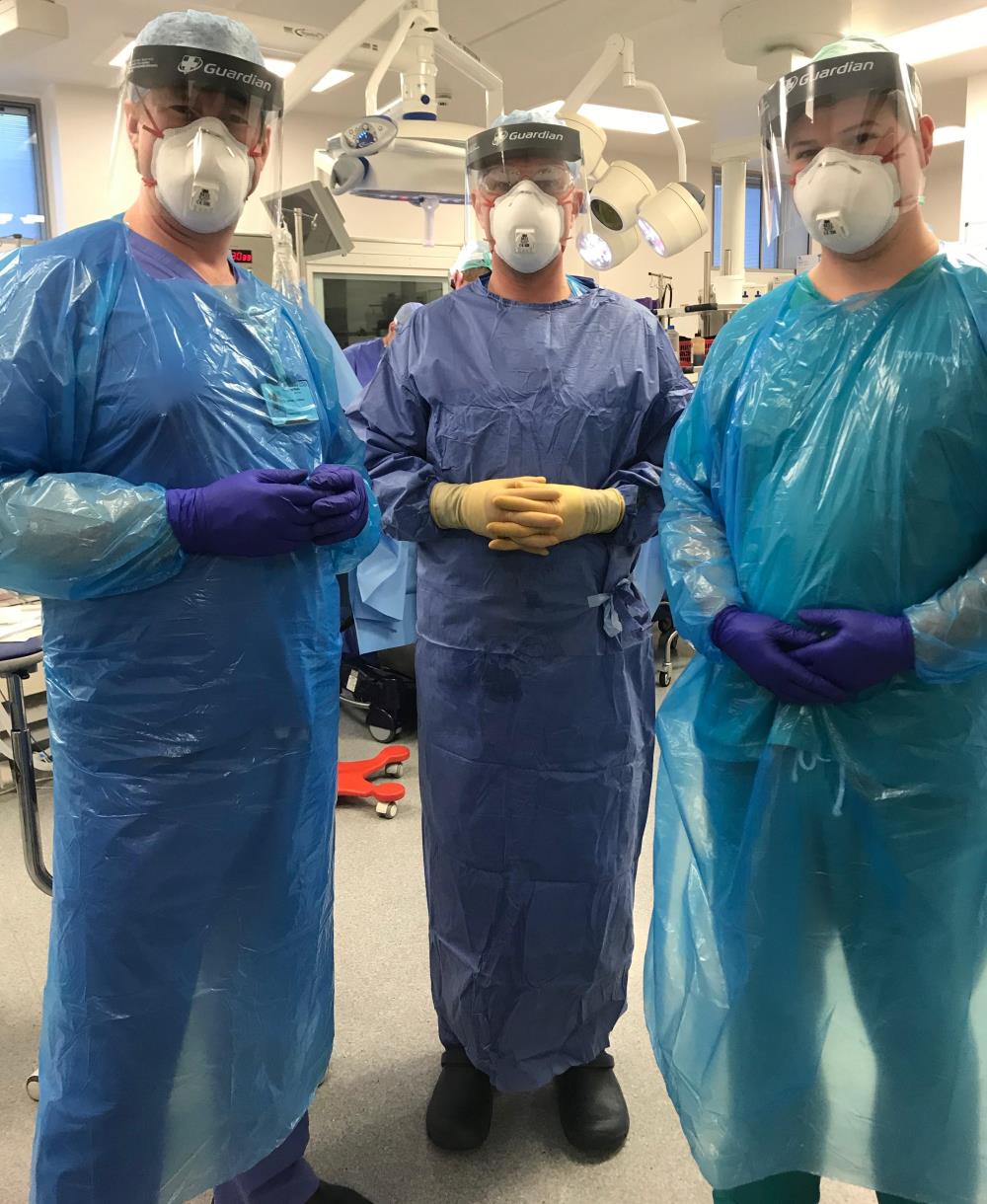Reflections from beneath the many layers of PPE

05 May 2020
Mr Liam Poynter
Liam Poynter is a trainee surgeon in Colorectal and General Surgery at Maidstone and Tunbridge Wells NHS Trust. He is also an Honorary Clinical Research Fellow at Imperial College London. In this blog series, he reflects on his first experience of performing emergency surgery, while wearing full personal protective equipment (PPE).
The hospital seems eerily quiet.
It is early days in the UK’s response to treating patients with COVID-19. Even for 8:15am, I would expect to hear the catering crews in full swing, porters scurrying around from the Emergency Department to Radiology. Aside from two anxious theatre staff in the corridors, nothing. The addition of green tape on the wall of the corridor as I turn into the newly designated ‘Green – Clean’ zone (for those patients proven COVID-free after testing), is noticeable.
Silence. I change into my scrub blues and put on my theatre shoes. Naturally, each shoe is at opposite ends of the changing room. At least some things remain unchanged.
I must have watched the donning and doffing videos countless times, but… gloves under the gown first? Gown, hat, respirator… is that the one I was ‘fit-tested’ for? Visor… my nursing colleague ‘buddy’, assigned to the donning station to assess that our PPE has been put on properly, checks me over. ‘You’re good.’ she says. The door to Theatre 1, which I have traversed countless times, now feels daunting.
The patient is already on the table. The usual chatter is a deafening white noise. Even the usual WHO safety checklist is a struggle; individuals are having to bellow through their respirators just to be heard. Who is the scrub nurse? All I can see are her eyes. It might be Judy, or Sue – this is why it is so important that we write our names on our visors.
We scrub over our gloves and aprons. More layers as my standard surgical gown and double gloves for laparotomy go on top. How will I be able to feel anything in this? Three gloves? Thank goodness I wore my contact lenses today; my glasses would be completely fogged up by now.
A grossly distended caecum – how has that not ruptured? A stenosed cancer in the hepatic flexure. I ease a triple-gloved finger into the plane. Everything feels so awkward beneath all of these layers. And the noise! Ordinarily, even music wouldn’t distract me. But I cannot pick out a single voice. At one point my consultant, mere inches from me, repeats himself four times just to get a simple message across, his voice muffled by the respirator.
Fear didn’t hit me until I saw it in my boss’s eyes. My mentor with 14 years’ experience as a consultant. What if this patient actually does have COVID-19? Does the diathermy plume pose a risk? What about the suction? That doesn’t go into a filter. Do all these people need to be in the theatre? I see his military training kick in. Calmness returns.
But fear affects decision-making. The bowel needed decompression. Could we purse-string a sucker into the small bowel? It didn’t work. Cue more swearing from my usually calm colleagues. The sweat is flowing down my back and front; my scrubs are soaked and I know it isn’t from the fluid washout. Hitherto unseen manoeuvres are tested. We stop. Let’s go back to basics. Keep it simple. The operation is completed. The patient is stable. Under ordinary circumstances she should do well. But, us not being used to performing life-saving surgery during a global pandemic, these are far from ordinary circumstances.
‘Doffing is more dangerous than donning.’ The words ring in our ears. Our surgical gowns are peeled off as usual. We are thankful for what lies beneath. We step over the threshold. We are so paranoid that we wash our hands after every manoeuvre. Finally… tentatively… the respirator comes off.
Did I feel relief after doffing? Only in so far as I could change my soaked scrub top. But I was left feeling exposed. The statistics coming out of Italy suggested that ‘Red Zones’ are the safest areas of the hospital for healthcare staff. Paradoxically, I now felt more vulnerable back in the Green Zone than at any time I was in theatre. The problem is, we just don’t have enough data. So much is based on supposition, on valiant ideas of best practice. For now, that is the best we have.
The overall feeling? It wasn’t just the physicality of wearing PPE that made things difficult, it has changed the entire concept of emergency operating. We realise that, at least for the foreseeable, it’s the new norm. We learnt so much from just one case: all names are now written on our visors to aid communication, a ‘one voice’ rule in theatre so people can hear each other. And the silver lining? Our patient made a rapid recovery, receiving excellent ward care from our nurses, junior doctors and the whole allied healthcare workforce. They were discharged home on the fifth post-operative day. Even during the COVID-19 pandemic, patients will still require emergency surgery. We have adapted and stand ready to serve.
Acknowledgements
With thanks to Mr STR Bailey and Mr A Khalil for their shared thoughts and valuable advice in the development of this article.
This blog is from our series COVID-19: views from the NHS frontline. If you would like to write a blog for us, please contact content@rcseng.ac.uk.

